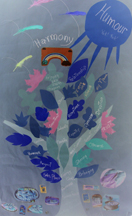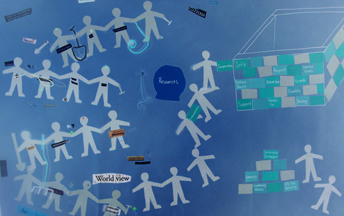The Learning Circles Project |
||
| The Workers Arts and Heritage
Centre
by Tracey Mollins |
||
Celebrating the Heritage of Working People in Hamilton, OntarioIn the spring of 1995, the Ontario Workers Arts and Heritage Centre bought the historic Custom House on Stuart Street in the North End of Hamilton in the heart of a working-class community and held a one-day, pre-renovation opening to celebrate the long working-class history of the building. In 1996, The Ontario Workers' Custom House re-opened as an interpretive centre for workers' history and culture. In 2001, The Ontario Workers Arts and Heritage Centre was re-named the Workers Arts and Heritage Centre (WAHC) to reflect its widening scope and mandate. The WAHC works to preserve and celebrate the art, culture and heritage of working people in Canada through traveling exhibits and research projects. They operate on a model similar to that of the Lower East Side Tenement Museum (www.tenement.org) that organized the International Coalition of Historic Site Museums of Conscience (www.sitesofconscience.org) to establish a new role for historic sites around the world as forums for civic dialogue and action. The WAHC works with groups to tell stories that are still alive and feel that many traditional museums have fallen out of step with the people who are making history. The Centre houses two permanent exhibits. Punching the Clock: Working in Canadian Factories, 1840s to 1980s is an interactive exhibit that details the lives and experiences of the Canadian men and women, past and present, who work in factories. The exhibit includes games, a slide show and ghost stories. All We Worked For: Exploring the Workers’ City explores the past lives and experiences, struggles and achievements, of Canadian workers that includes the video, All We Worked For, the Bread and Roses board game, where participants role-play a wife and mother struggling to get by in the Great Depression. “…and still I rise”: A History of African Canadian Workers in Ontario, 1900 to Present presents the story of the lives and experiences of African Canadians and is the Centre’s travelling exhibit. The exhibit is interactive and includes a role-playing activity and screening of the film Journey to Justice. The WAHC has a Virtual Museum Canada (www.virtualmuseum.ca) exhibit called Highway Workplace: The Canadian Trucker's Story (www.virtualmuseum.ca/Exhibitions/Highway/en/index.html) that explores the history and culture of truckers by looking at the daily life of the Canadian trucker and the history of the Canadian trucking industry and its unions. The WAHC Research Service and Support provides support and staff to work with union locals who want to research their history, organize records, interview members past and present, organize displays, and/or produce a booklet or video. At any given time, the WAHC may be working with partners and supporting the work of a number of community-based projects such as oral history projects, health and safety exhibits, and culture and language reclamation projects. They work with community groups, seniors, youth, newcomers, immigrants and unions to keep the story of ordinary Canadians at the forefront. The WAHC sees itself as part of the community and participates in community revitalization in the north end of Hamilton, for many years considered a rough area of town that could not attract businesses. Since the Centre opened, businesses have come to the area along with services such as a women’s shelter and a community development project. The WAHC is used by community groups and unions and the staff works hard to keep this resource open and affordable. On the day I was there, there was a walking tour for union members in town for a conference, a sewing group where children were learning traditional artwork from elders, a pride day festival in front of the building and a drag show in the garden. The WAHC is not driven by the needs and requirements of funders. They receive no stable core funding to run the museum. They receive some financial support through memberships, member donations, book and resource sales and donations and grants from unions. Apart from that, they are funded project by project and this makes it hard for them to plan for the long term. The board is made up of activists, academics and community workers. Some ideas for exhibits and projects come from the board or staff. Once an idea is agreed upon, the staff works to find partners and funding for the project. Sometimes the WAHC is approached by organizations who want support to tell their story. In this case the WAHC works as a resource; they help the group find partners and funding and provide expertise. The WAHC staff takes an advisory role and act as consultants rather than directors of the projects. The WAHC regards its visitors as participants. They produce walking tour booklets and audiotapes for each exhibit. They also produce educational materials so that groups, especially school groups, can prepare for their visit and follow up with related research and activities. The WAHC staff also works hard to make sure that their exhibits and projects accessible and inviting to a non-traditional museum-going audience and people whose stories are often excluded from museums. They are not comfortable with exhibits that are didactic or test-based. They design exhibits based on the theory of multiple intelligences. In 1983, developmental psychologist Howard Gardner proposed that people have several kinds of intelligence, and that teachers can only reach all of their students by adapting their lessons to each of these types of intelligences*. The WAHC works to make sure that all visitors/participants can find a way in to the exhibits by including a range of activities and ways to interact with the material. They use audio, video, story-telling, music, games, drama, and walking tours. Each piece of text is accompanied by bold graphics. The former executive director, Mary Breen, has a background as a literacy worker and brought her expertise in clear language and design and making information accessible to people regardless of reading ability to the WAHC. A current board member is a person who learned to read as an adult. He shares his experiences and expertise with staff. All text is of clear design and written at a grade five level. It is also placed at a level where it can be read easily by a person in a wheel chair. The WAHC works to build sustainable relationships with its partners and audience by proving to them that their lives, experiences and knowledge matter. * Types of intelligences
|
||

